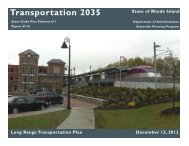Land Use 2025 - RhodeMap RI
Land Use 2025 - RhodeMap RI
Land Use 2025 - RhodeMap RI
- No tags were found...
You also want an ePaper? Increase the reach of your titles
YUMPU automatically turns print PDFs into web optimized ePapers that Google loves.
density or medium-high density development is planned other than to replace existinghousing at those densities, at a rate less than one for one.Based on an analysis of trends in household size and demographic projections ofhousehold formations (see Technical Appendix B), the number of year-round occupiedhousing units is projected to range from 425,781 to 443,375 occupied units over theplanning horizon (<strong>2025</strong>). In terms of number of additional units projected for the period,the minimum-maximum ranges are 17,267 to 36,798.Using the higher end of the range, if all residential units are distributed according toexisting density patterns prevalent in Rhode Island in 1995, the additional residential arearequired would total 22,485 acres. Thus, the total residential acreage requirements in<strong>2025</strong> would be 161,169 (138,684 existing plus 22,485 added acres). However, if theprojected net growth in housing of 36,798 units were distributed in a density pattern thatreflects 1995 zoning, the additional residential acreage required would total 95,000 acres.Added to the existing 1995 residential acreage of 138,700, this would render a <strong>2025</strong>residential land use total of 233,700 acres – a 68 percent increase.While none of the above figures for housing growth and increase in residential acreagecan be known with certainty, it can be stated with reasonable assurance that:• Rhode Island can expect continued housing growth, and• The increase in residential acreage is likely to outpace housing unit growth by asubstantial factor.4-3 <strong>Land</strong> Needed for Economic ActivitiesMuch of Rhode Island’s land resources are allocated to support a robust and growingeconomy. Economic activities are dependent on the availability of suitable locations.Although the locational requirements of many business sectors are a great deal differentin the Information Age from what they were in the Industrial Era, a fundamental premiseis that land will still be required for them.The dependence on land resources is both quantitative and qualitative. Quantitativerequirements may be estimated based on trends, formulas, and rules of thumb.Qualitative requirements add variables that may compound initial quantitativeassessments. Both dimensions of need are changeable, and continuingly changing, in arapidly evolving economy. This section attempts to provide, based upon availableprojections and trends, a baseline quantitative estimate of land needed in <strong>2025</strong> toaccommodate economic activities.It is assumed here that Rhode Island’s economy, including its employment opportunities,will continue to expand to meet the needs of its population for a high standard of living.That is the goal of the primary economic development element of the State Guide Plan,the Economic Development Policies and Plan, and all State economic policy. However,<strong>Land</strong> <strong>Use</strong> <strong>2025</strong>: Rhode Island State <strong>Land</strong> <strong>Use</strong> Policies and Plan (April 2006) 4-3
















